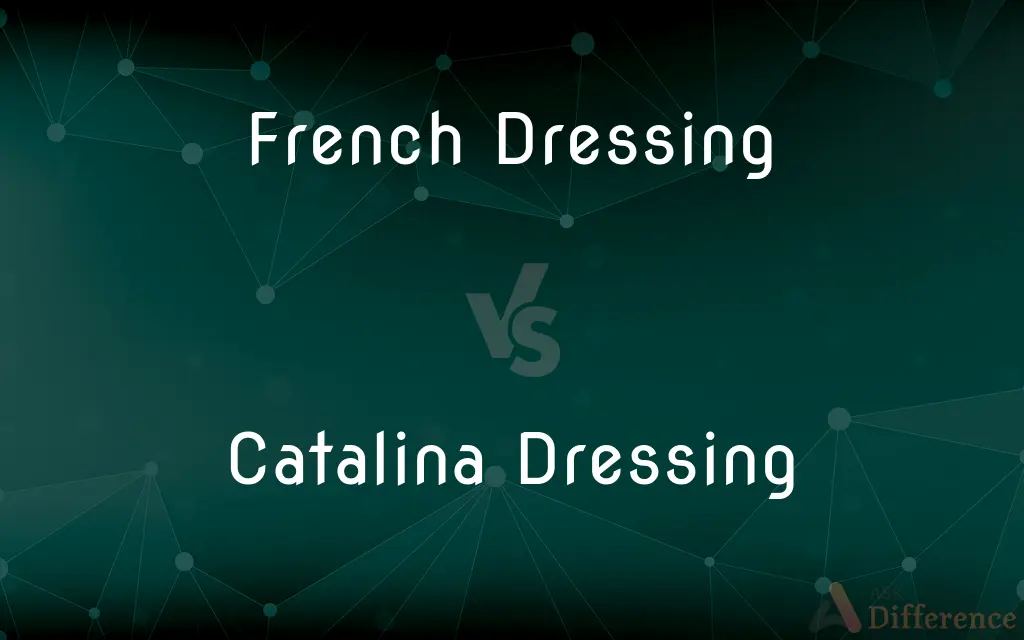French Dressing vs. Catalina Dressing — What's the Difference?
By Tayyaba Rehman & Fiza Rafique — Published on March 3, 2024
French dressing is a sweet, tangy vinaigrette, usually light orange, while Catalina dressing is a type of French dressing that's redder, tangier, and less sweet, often with a thicker consistency.

Difference Between French Dressing and Catalina Dressing
Table of Contents
ADVERTISEMENT
Key Differences
French dressing, known for its sweet and tangy flavor profile, is a popular choice for salad dressings in the United States. It's characterized by its light orange color, which comes from a blend of vinegar, oil, sugar, and tomato paste or ketchup, along with various seasonings. Catalina dressing, on the other hand, is a variant of French dressing with a bolder, tangier taste and a deeper red hue. It often includes ingredients like Worcestershire sauce or soy sauce to intensify its flavor.
Both dressings share a common base of ingredients including vinegar, sugar, and tomato, while Catalina dressing typically has a thicker consistency and a more pronounced tanginess compared to the lighter and sweeter French dressing. This difference makes Catalina a preferred option for those who enjoy a zestier salad dressing or a versatile marinade.
The sweetness level in French dressing comes from a higher sugar content, making it a favorite for those who prefer a milder, sweeter dressing. Catalina dressing, with its reduced sugar content and additional acidic components, appeals to those looking for a dressing with a sharper bite.
The versatility of both dressings extends beyond salads, with French dressing often used as a dip or topping for vegetables, and Catalina dressing serving as a popular marinade for meats, thanks to its robust flavor. This adaptability makes both dressings staples in American kitchens.
Both French and Catalina dressings offer a balance of sweetness and tanginess, but their differences lie in the intensity of flavor, color, and consistency. French dressing is milder and sweeter, ideal for light salads, whereas Catalina dressing, with its tangier and thicker composition, suits a wider range of culinary uses, from salads to marinades.
ADVERTISEMENT
Comparison Chart
Color
Light orange
Deeper red
Taste
Sweeter and milder
Tangier and less sweet
Consistency
Generally lighter
Thicker
Common Ingredients
Vinegar, oil, sugar, tomato paste, spices
Vinegar, oil, less sugar, tomato paste, Worcestershire sauce, spices
Culinary Uses
Salad dressing, dip for vegetables
Salad dressing, marinade for meats
Compare with Definitions
French Dressing
A sweet and tangy light orange vinaigrette.
She drizzled French dressing over her green salad for a touch of sweetness.
Catalina Dressing
A versatile dressing that enhances the flavor profile of meals.
Catalina dressing is her go-to for both salads and marinades.
French Dressing
Known for its smooth, pourable consistency.
French dressing coats the salad leaves evenly without weighing them down.
Catalina Dressing
Contains less sugar and more acidic ingredients.
Catalina dressing's tanginess comes from its unique blend of vinegar and Worcestershire sauce.
French Dressing
Often made with a base of vinegar, oil, and tomato paste.
His homemade French dressing included a blend of apple cider vinegar and sunflower oil.
Catalina Dressing
Often used as a marinade for meats.
She marinated chicken in Catalina dressing for a zesty flavor.
French Dressing
Can be used as a flavorful dip.
They served French dressing as a dip for their vegetable platter.
Catalina Dressing
Its robust taste complements a variety of dishes.
Catalina dressing added a tangy kick to the pasta salad.
French Dressing
Popular in American cuisine for its mild, sweet taste.
French dressing is a staple in her kitchen for quick and easy salads.
Catalina Dressing
A tangier, thicker variant of French dressing with a deep red color.
He preferred Catalina dressing for its bold flavor on his taco salad.
Common Curiosities
What's the main difference between French dressing and Catalina dressing?
French dressing is sweeter and milder, while Catalina is tangier, thicker, and has a deeper red color.
Why is Catalina dressing red?
The deeper red color comes from the higher concentration of tomato paste or ketchup and possibly additional coloring.
Is French dressing the same as vinaigrette?
French dressing is a type of vinaigrette but with specific characteristics like sweetness and a light orange color.
Can both dressings be used as marinades?
Yes, but Catalina dressing is preferred for marinades due to its tangier flavor.
Can I substitute Catalina dressing for French dressing in recipes?
Yes, but expect a tangier and slightly less sweet flavor profile.
How long can I store homemade French or Catalina dressing?
Typically up to 1-2 weeks in the refrigerator, in airtight containers.
Can I make these dressings at home?
Absolutely, homemade versions allow for adjusting sweetness and tanginess to taste.
Are these dressings gluten-free?
It depends on the ingredients used, especially in store-bought versions; always check the label.
Is there a low-fat version of these dressings?
Yes, both can be made in low-fat versions by substituting ingredients.
Why would I choose Catalina over French dressing?
If you prefer a tangier, less sweet dressing with a thicker consistency.
What makes French dressing sweet?
The sweetness comes from added sugar or sweeteners in the recipe.
Are these dressings vegan?
Homemade versions can be made vegan, but store-bought versions may contain non-vegan additives.
Do these dressings contain dairy?
Generally, no, but always check labels or recipes to be sure.
Can I use French or Catalina dressing on a fruit salad?
French dressing can be used for a sweet twist, but Catalina might be too tangy.
Can diabetics consume these dressings?
In moderation and preferably homemade versions where sugar content can be controlled.
Share Your Discovery

Previous Comparison
Hand Cream vs. Lotion
Next Comparison
Venting vs. ComplainingAuthor Spotlight
Written by
Tayyaba RehmanTayyaba Rehman is a distinguished writer, currently serving as a primary contributor to askdifference.com. As a researcher in semantics and etymology, Tayyaba's passion for the complexity of languages and their distinctions has found a perfect home on the platform. Tayyaba delves into the intricacies of language, distinguishing between commonly confused words and phrases, thereby providing clarity for readers worldwide.
Co-written by
Fiza RafiqueFiza Rafique is a skilled content writer at AskDifference.com, where she meticulously refines and enhances written pieces. Drawing from her vast editorial expertise, Fiza ensures clarity, accuracy, and precision in every article. Passionate about language, she continually seeks to elevate the quality of content for readers worldwide.
















































